Understanding ABA Therapy in Autism Skill Centers
Applied Behavior Analysis (ABA) therapy stands as a cornerstone in autism treatment, offering scientifically-backed methods that support children and youth with Autism Spectrum Disorder (ASD). Autism skill centers leverage these principles in structured and individualized programs designed to foster communication, social interaction, and daily living skills. This article explores how ABA therapy is implemented within such centers, the qualified professionals behind it, targeted goals, and the measurable outcomes that demonstrate its effectiveness.
What is ABA Therapy and How Does It Help Individuals with Autism?
Definition of ABA Therapy
Applied Behavior Analysis (ABA) therapy is a scientifically supported approach that studies how behavior works and how it is influenced by the environment. It focuses on increasing helpful behaviors and decreasing those that can be harmful or interfere with daily life.
Core Principles of ABA
ABA relies on the principle of learning through consequences. Positive reinforcement, where a desirable reward follows a behavior, encourages that behavior to recur. The therapy uses the 'A-B-Cs' framework — antecedent (what happens before), behavior (the action itself), and consequence (the result) — to understand and adjust behaviors effectively.
How ABA Improves Autism Symptoms
ABA therapy is highly effective in enhancing skills vital for individuals with autism spectrum disorder (ASD). It improves language and communication, social skills, attention and focus, memory, academic abilities, and reduces problematic behaviors. These improvements support more independent and fulfilling lives.
Settings for ABA Delivery
ABA can be customized for different needs and offered in various environments: at home, in school, or within the community. Therapy sessions may be one-on-one or conducted in groups, depending on what best suits the individual's goals.
Techniques Used in ABA
Common techniques include Discrete Trial Training (DTT), which breaks down skills into simple steps with immediate reinforcement, and Pivotal Response Training (PRT) that targets essential skills in natural settings. These methods help teach and reinforce new skills systematically.
Role of Reinforcement and the ABC Framework
The therapy uses positive reinforcement strategically to increase desired behaviors. By analyzing antecedents and consequences surrounding a behavior, ABA helps create effective plans to encourage helpful actions and decrease undesirable ones.
Individualization of Programs
Each ABA program is tailored by qualified Board Certified Behavior Analysts (BCBAs) who assess individual strengths and needs. Programs set goals in areas like communication, social and motor skills, self-care, play, and academics, with ongoing data collection to monitor progress.
Evidence Base Supporting ABA
ABA is recognized by authorities such as the US Surgeon General and the American Psychological Association as an evidence-based best practice. Extensive research shows that intensive, long-term ABA therapy leads to significant improvements in cognitive functioning, language abilities, social interactions, and daily living skills for children with autism.
| Aspect | Description | Why It Matters |
|---|---|---|
| ABA Definition | Science-based therapy focused on learning and behavior | Ensures treatment is grounded in research |
| Core Principles | Positive reinforcement, ABC framework | Provides clear techniques to modify behavior |
| Impact on Autism Symptoms | Enhances communication, social skills, reduces problem behaviors | Directly improves quality of life |
| Delivery Settings | Home, school, community, one-to-one or group | Flexibility accommodates individual needs |
| Techniques | DTT, PRT, and others | Targets skill-building and behavior modification |
| Individualization | Tailored programs by BCBAs with goal-setting and data tracking | Customized to maximize effectiveness |
| Research Support | Recognized by expert bodies, multiple studies show positive outcomes | Confirms reliability and effectiveness |
Key Techniques Utilized in ABA Therapy
What is Discrete Trial Training (DTT)?
Discrete Trial Training (DTT) is a highly structured ABA technique that involves breaking down skills into small, manageable steps. Instructions are given clearly and directly, and correct responses are immediately followed by positive reinforcement, such as a reward. Undesired behaviors or incorrect responses are typically ignored to reduce their occurrence.
How Does Pivotal Response Training (PRT) Work?
Pivotal Response Training (PRT) is a naturalistic ABA method conducted in everyday settings like home or community environments. It focuses on improving "pivotal" behaviors such as initiating communication, which can broadly impact other skills. PRT uses motivational strategies and child choice to encourage engagement and learning.
What is Functional Communication Training (FCT)?
Functional Communication Training (FCT) aims to replace challenging or disruptive behaviors with appropriate communication methods. By teaching an individual to express their needs effectively, FCT reduces frustration and helps develop useful social interactions.
What is Natural Environment Training (NET)?
Natural Environment Training (NET) involves teaching skills within the context of daily activities and routines. This approach helps learners apply their skills spontaneously and generalize them across different settings, making learning more meaningful and functional.
How Does ABA Use Positive Reinforcement Strategies?
Positive reinforcement is central to ABA therapy. When a desired behavior occurs, it's followed by a valued reward, such as praise, tokens, or activities the individual enjoys. This encourages repetition of the behavior, gradually building new skills and reducing problem behaviors.
What is the Role of the 'A-B-Cs' Framework?
ABA therapists use the Antecedent-Behavior-Consequence (A-B-C) framework to understand and modify behaviors. By identifying what happens before (antecedent) and after (consequence) a behavior, therapists can design interventions that encourage helpful behaviors and reduce undesired ones.
| Technique | Description | Typical Settings |
|---|---|---|
| Discrete Trial Training (DTT) | Structured, step-by-step skill teaching with clear instructions | Clinic, home |
| Pivotal Response Training (PRT) | Child-led teaching focusing on motivation and pivotal skills | Natural/home community |
| Functional Communication Training (FCT) | Improving communication to replace problem behaviors | Various |
| Natural Environment Training (NET) | Skill teaching within daily routines and natural settings | Home, school, community |
| Positive Reinforcement | Rewards used to strengthen desired behaviors | All settings |
| 'A-B-Cs' Framework | Analyzing antecedent-behavior-consequence to guide interventions | All settings |
Who Provides ABA Therapy in Autism Skill Centers?
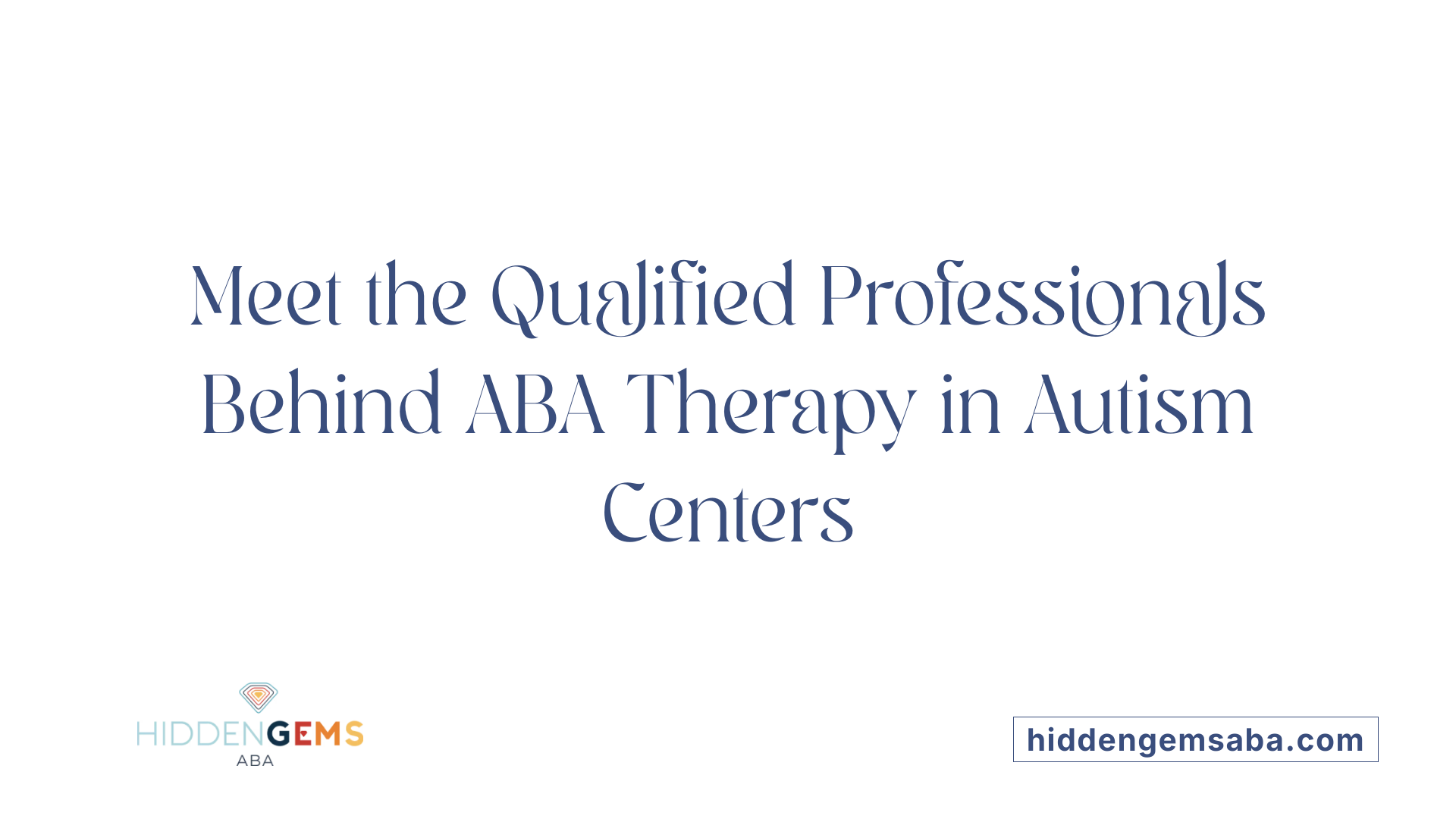
Qualified professionals involved in ABA therapy
ABA therapy for individuals with autism is predominantly provided by trained specialists who understand behavioral science deeply. The most common professionals involved are Board Certified Behavior Analysts (BCBAs) and Registered Behavior Technicians (RBTs).
Roles of Board Certified Behavior Analysts (BCBAs) and Registered Behavior Technicians (RBTs)
BCBAs are highly qualified experts who design and oversee ABA treatment plans. They assess the individual's needs, set goals, and continuously monitor progress through data collection. RBTs, on the other hand, often implement therapy sessions directly with the client under BCBA supervision, utilizing techniques like Discrete Trial Training (DTT) and Pivotal Response Training (PRT).
Accreditation and quality standards
Reputable ABA providers maintain accreditation through organizations such as the Behavior Analyst Certification Board (BACB) and the Behavioral Health Center of Excellence (BHCOE). These accreditations ensure providers follow rigorous standards for quality and efficacy in delivering ABA therapy.
Settings where ABA therapy is delivered
ABA therapy is adaptable and may be provided in various environments including autism skill centers, homes, schools, and community settings. Autism skill centers typically offer a structured environment where therapy can be delivered consistently with access to specialized resources and multidisciplinary teams.
Importance of provider qualifications
Selecting providers with proper certification and experience is critical to ensuring effective treatment. Qualified providers develop personalized plans geared to the individual’s strengths and challenges, supporting progress in areas like communication, social skills, and daily living abilities.
How families can identify qualified providers
Families interested in ABA therapy should consult healthcare professionals, verify insurance coverage, and research provider credentials. Key factors include BCBA certification, provider accreditation, experience with autism populations, and positive client outcomes reported through data-based assessments.
| Professional Role | Responsibilities | Credentials & Certification |
|---|---|---|
| Board Certified Behavior Analyst (BCBA) | Designs, supervises, and modifies treatment plans | Certified by BACB with advanced education and training |
| Registered Behavior Technician (RBT) | Delivers therapy sessions under BCBA supervision | Certification following BACB-approved training |
| Autism Skill Center Staff | Multidisciplinary support, structured learning environment | Various credentials including BCBAs, therapists |
Typical Goals and Outcomes Targeted by ABA Therapy
What are the typical goals and outcomes targeted by ABA therapy in autism treatment?
ABA therapy in autism treatment focuses on enhancing fundamental skill sets and reducing behaviors that interfere with learning and daily functioning. Core skill areas targeted include communication and language development, social skills and interaction, adaptive and daily living skills, academic and motor skills, alongside behavior reduction goals.
Core skill areas targeted by ABA
ABA programs are tailored to each individual, with goals set by certified behavior analysts following detailed assessments. These goals often cover:
- Communication and Language: Improving both expressive and receptive language capabilities to enhance effective communication.
- Social Skills and Interaction: Developing abilities to engage appropriately with peers and adults, essential for community integration.
- Adaptive and Daily Living Skills: Teaching self-care and practical routines to increase independence.
- Academic and Motor Skills: Promoting learning in academic contexts and physical coordination abilities.
- Behavior Reduction: Decreasing harmful or obstructive behaviors that impede progress or safety.
Individualization and goal setting
Each treatment plan is custom-built, reflecting the unique needs and strengths of the learner. Positive reinforcement and systematic approaches like the A-B-C framework—addressing antecedents, behaviors, and consequences—are employed to encourage desired behaviors and diminish unwanted ones.
Impact of treatment intensity and duration
Research supports that intensive ABA therapy, typically involving 25 to 40 hours weekly over one to three years, yields significant improvements, particularly in language, cognitive functioning, and social skills. The sustained and consistent application of ABA principles helps build foundational skills that contribute to greater autonomy and an improved quality of life for individuals with autism.
Measuring the Effectiveness of ABA Therapy
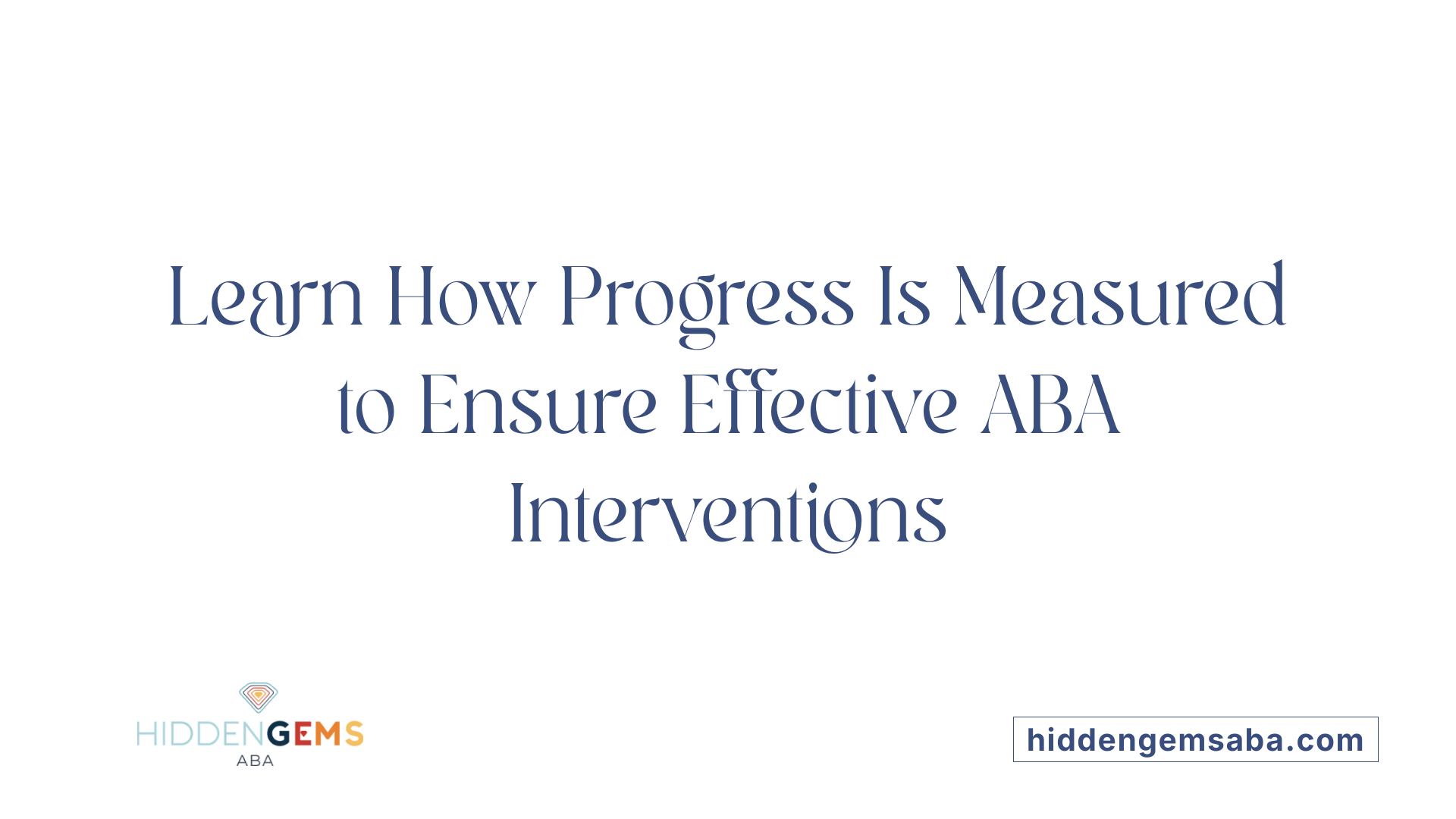
How is the Effectiveness of ABA Therapy Measured in Individuals with Autism?
ABA therapy's effectiveness is closely monitored through systematic data collection and behavioral assessments. Qualified behavior analysts (BCBAs) gather detailed information on how the individual is progressing toward personalized treatment objectives. These assessments cover a broad range of domains including communication, social skills, daily living, and problem behaviors.
Data Collection and Behavioral Assessments
One major method to measure progress is by consistently recording behavior as it occurs—this can include frequency counts, duration, or intensity of behaviors. These data help professionals analyze patterns and the impact of interventions, enabling ongoing adjustments to therapy plans.
Use of Standardized Tools and Frameworks
Standardized assessment tools provide reliable and objective measures of skill acquisition and behavioral improvements. The Behavior Health Center of Excellence (BHCOE) ABA Outcomes Framework encourages the use of common, evidence-based outcome measures, fostering consistency across different providers and programs.
Tracking Progress on Individualized Goals
Each ABA program is tailored to the individual learner’s needs, with goals spanning communication, social interaction, academic abilities, and self-care. Progress toward these goals is regularly evaluated, ensuring that therapy remains aligned with the person’s evolving requirements.
Role of the BHCOE ABA Outcomes Framework
The BHCOE framework supports clinicians by standardizing how outcomes are reported. It serves as a tool for clinical quality improvement and facilitates comparisons between programs, contributing to overall better care for clients.
Importance of Treatment Intensity and Duration
Research highlights that the effectiveness of ABA is often linked to how intensively and how long therapy is provided, with 25-40 hours per week over 1-3 years yielding significant improvements, particularly in language, communication, and adaptive functioning.
Reported Improvement Rates in Research Studies
Studies reveal that ABA therapy yields improvement rates ranging between 63% and 88% across cognitive, language, and social-communication skills. These findings underscore ABA's role as an evidence-based intervention for Autism Spectrum Disorder.
Comprehensive ABA-Based Treatment Models
What Are Early Intensive Behavioral Intervention (EIBI), Early Start Denver Model (ESDM), and LEAP?
Early Intensive Behavioral Intervention (EIBI) is a well-established, comprehensive ABA-based program that provides intensive therapy, typically 25-40 hours per week. It targets a broad range of skills including cognition, communication, social, and daily living skills, with individualized goals set by qualified behavior analysts.
The Early Start Denver Model (ESDM) is a developmental ABA approach designed for young children aged 12 to 48 months. It blends ABA principles with play and social interaction to promote language, cognitive, and social skills within naturalistic settings.
LEAP (Learning Experiences: An Alternative Program for Preschoolers and Their Parents) integrates ABA techniques in a classroom environment, focusing on inclusive education where children with autism learn alongside their typically developing peers.
How Do These Models Integrate Multiple Developmental Areas?
All three models emphasize holistic development. They address multiple domains such as:
- Communication and language development
- Social skills and emotional reciprocity
- Motor and play skills
- Academic readiness and cognitive functioning
- Self-care and adaptive behavior
This multifaceted approach ensures that interventions do not focus on isolated skills but rather support overall growth tailored to each child’s needs.
What Role Does Play and Social Interaction Have in Therapy?
Especially notable in models like ESDM is the central role of play and social engagement. These natural contexts foster motivation and provide opportunities to practice pivotal skills such as initiating communication, turn-taking, and joint attention. The use of play enhances learning by creating enjoyable and meaningful experiences for children.
How Do Developmentally Based Approaches Fit Within ABA?
Developmentally based ABA approaches blend ABA's structured behavioral techniques with sensitivity to typical developmental sequences. They focus on building foundational skills before moving to more complex tasks, often using naturalistic strategies that promote generalization and spontaneous use of learned behaviors. This integration helps make therapy more effective and child-friendly, aligning teaching moments with developmental readiness.
Together, these comprehensive ABA treatment models offer flexible, evidence-based frameworks designed to improve functional outcomes for children with autism across all areas of development.
The Role of Autism Skill Centers in Delivering ABA
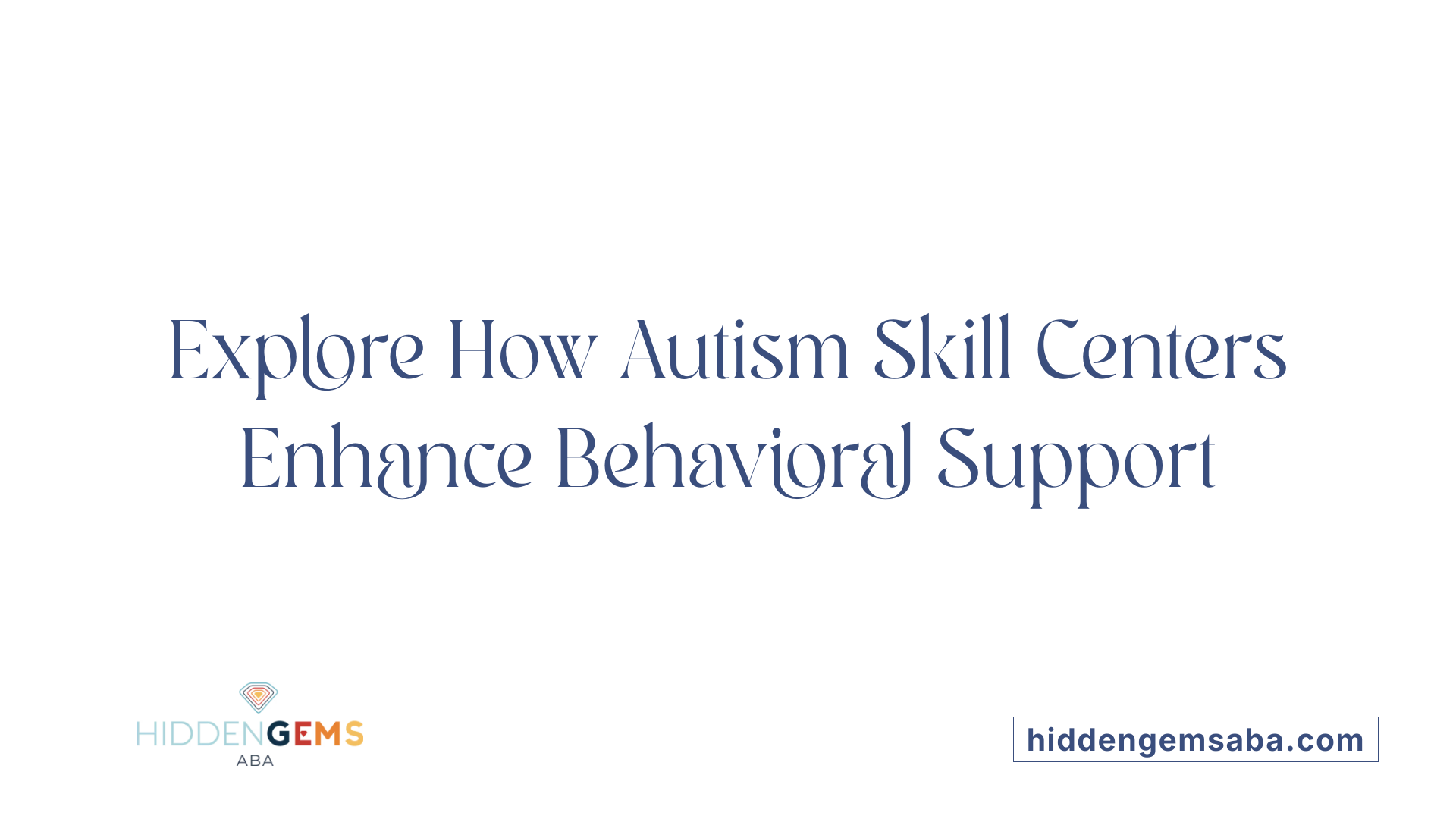
Structure and Routine in Center-Based ABA
Autism skill centers provide a structured environment essential for effective ABA therapy. These centers maintain consistent routines that help children with ASD become familiar with their daily schedules, reducing anxiety and fostering better learning conditions.
Access to Specialized Resources and Equipment
Centers are equipped with specialized teaching tools and resources designed to support behavioral interventions. This equipment includes visual aids, communication devices, and sensory tools that are not typically available at home settings, enhancing the delivery of tailored ABA programs.
Opportunities for Peer Social Interaction
One significant advantage of center-based ABA is the chance for children to engage with peers. Social skill development is a crucial focus, and peer interactions during therapy sessions encourage practicing communication, cooperation, and emotional regulation in a controlled environment.
Multidisciplinary Team Approach
Autism skill centers operate with a team of qualified professionals including Board Certified Behavior Analysts (BCBAs), Registered Behavior Technicians (RBTs), and sometimes speech or occupational therapists. This collaborative approach ensures comprehensive assessment, treatment planning, and progress monitoring.
Benefits Over Home-Only Therapy
While home-based ABA therapy offers familiarity, center-based therapy provides a distraction-controlled setting that can minimize interruptions and maximize learning. The presence of multiple professionals allows for more specialized instruction and immediate adjustment of techniques based on ongoing data collection.
Flexibility in Therapy Intensities and Schedules
Centers can offer various intensities of ABA therapy, ranging from a few hours a week to intensive 25–40 hours per week programs. This flexibility accommodates individual needs, allowing gradual or comprehensive treatment plans tailored to the child's progress and family schedules.
Insurance Coverage and Accessibility of ABA Therapy
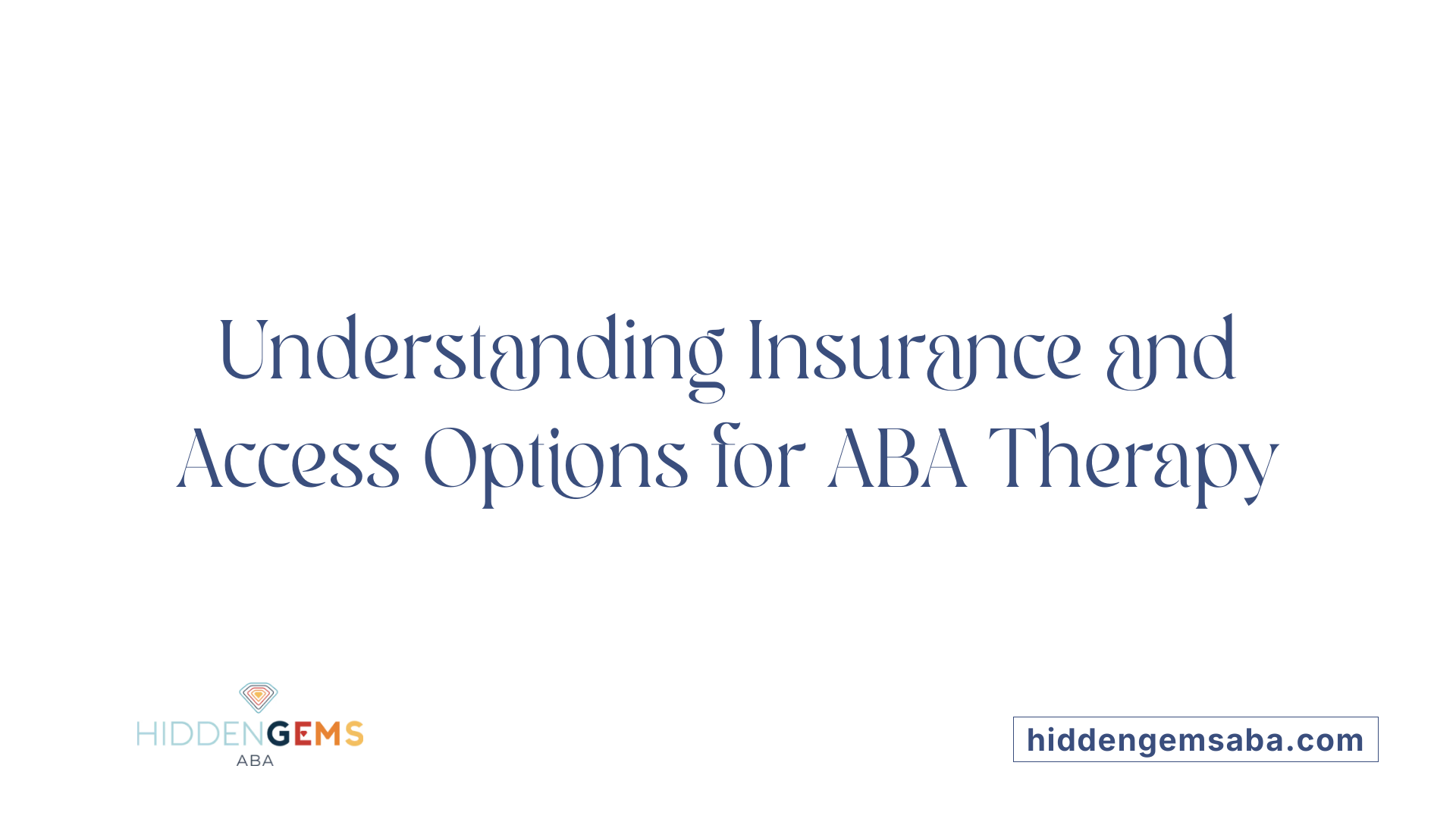
How Does Private Insurance Cover ABA Therapy?
Many private insurance plans are mandated to provide coverage for Applied Behavior Analysis (ABA) therapy if it is deemed medically necessary. This ensures that a significant number of children and youth with Autism Spectrum Disorder (ASD) can access evidence-based treatments without bearing the full financial burden.
What Role Does Medicaid Play in ABA Coverage?
Medicaid also supports ABA therapy for children under 21 years old. Coverage under Medicaid requires that the therapy is prescribed by a qualified medical professional, facilitating access for families who qualify for this program.
What Documentation Is Needed to Prove Medical Necessity?
To obtain insurance approval, comprehensive documentation is essential. This typically includes assessments conducted by certified behavior analysts (BCBAs), detailed treatment plans, and ongoing progress reports supported by systematic data collection. These documents demonstrate why ABA therapy is necessary for the individual's development.
How Can Families Navigate Insurance for ABA Therapy?
Families can take several steps to manage insurance coverage effectively. Consulting healthcare providers experienced in ABA can help to identify qualified insurance providers. It is beneficial to verify the specifics of coverage early, confirm which providers are in-network, and ask key questions about what services and hours are included.
What Financial Challenges Might Families Face?
While insurance coverage has improved, some families may still encounter challenges such as co-pays, deductibles, or limits on therapy hours. Understanding plan details and seeking out resource guides or advocacy services can help families overcome financial barriers to accessing optimum ABA therapy.
| Aspect | Description | Notes |
|---|---|---|
| Private Insurance Coverage | Often required to cover ABA if medically necessary | Coverage varies by plan and state |
| Medicaid | Covers ABA for children under 21 with a doctor’s prescription | Supports low-income families |
| Documentation | Assessment reports, treatment plans, progress data | Critical for claim approval |
| Family Navigation | Consulting providers, verifying insurance details, asking informed questions | Important for maximizing benefits |
| Financial Considerations | Co-pays, deductibles, session limits | May require additional financial support or advocacy |
Integration of ABA with Other Therapeutic Approaches
How Does ABA Combine with Developmental Therapies?
ABA is often integrated with developmental approaches like speech and language therapy to enhance communication and developmental milestones. These combined methods harness ABA’s behavior modification techniques alongside developmental principles to foster improvements in language and other skills.
What Role Do Educational Treatments Like TEACCH Play?
TEACCH focuses on visual learning and structured classroom environments to support children with autism. ABA therapy can complement TEACCH by targeting behavior changes within these structured settings, helping children adapt better and develop academic and social skills.
How Do Social-Relational Approaches Complement ABA?
Social-relational therapies such as DIR/Floor Time, Relationship Development Intervention (RDI), Social Stories, and social skills groups aim to strengthen social interaction and emotional bonds. Integrating these with ABA allows a balance between structured behavior modification and naturalistic social development.
What Psychological Therapies Address Co-occurring Symptoms?
Psychological approaches like Cognitive-Behavior Therapy (CBT) are utilized alongside ABA to manage anxiety, depression, or other mental health issues that often accompany autism. This dual approach supports holistic well-being beyond core ASD symptoms.
What Is the Role of Medication for Associated Conditions?
While no medications treat core ASD symptoms, certain medicines help control co-occurring problems such as high energy, focus difficulties, anxiety, depression, seizures, sleep disturbances, or gastrointestinal issues. These medications may be used in conjunction with ABA and other therapies to provide comprehensive care.
By combining ABA with these varied approaches, treatment plans become more individualized and holistic, addressing both behavior and other developmental or health needs.
Historical Foundations and Scientific Basis of ABA
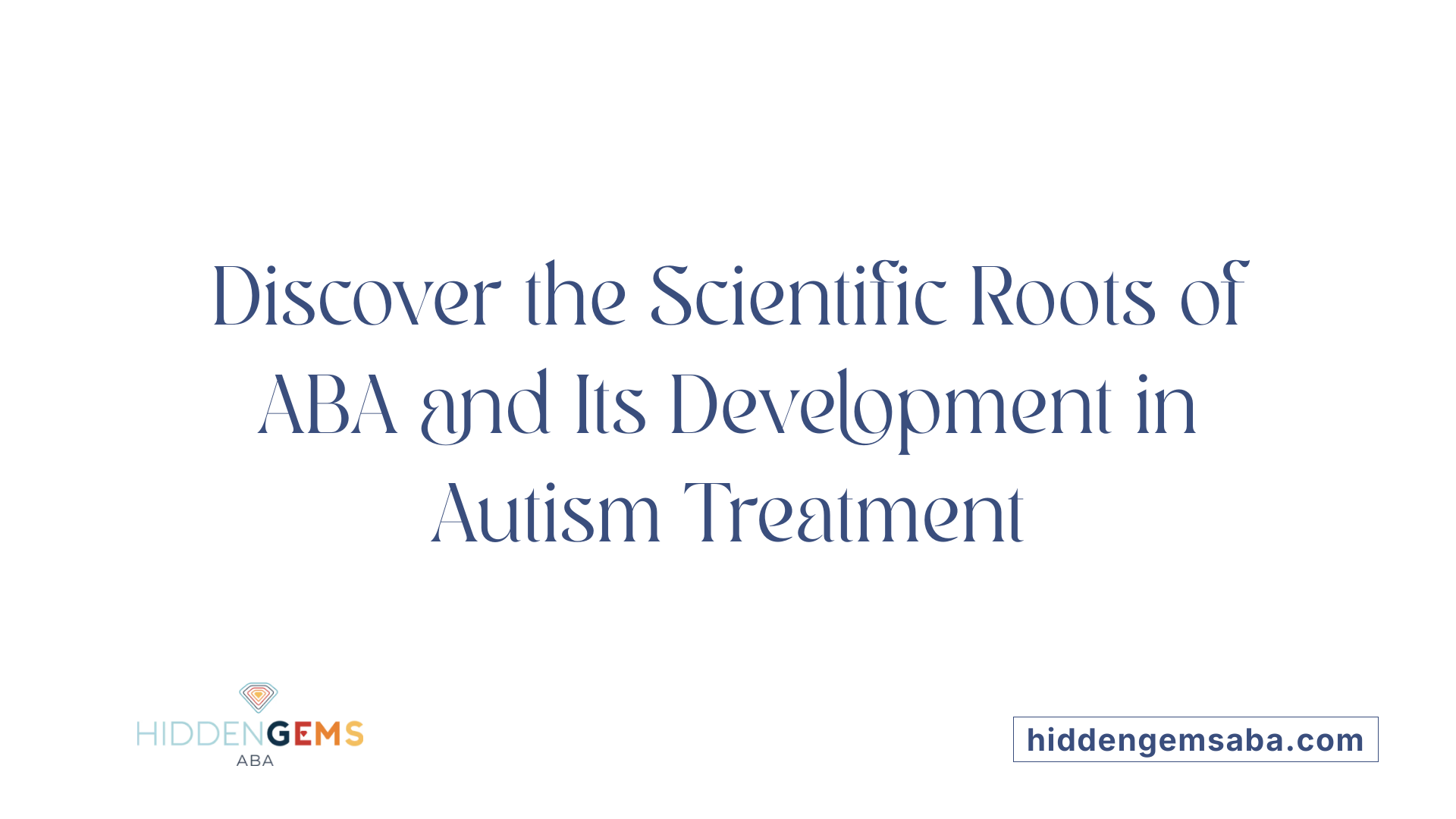
Origins rooted in learning theory and operant conditioning
Applied Behavior Analysis (ABA) is grounded in the science of learning and behavior, with its origins tracing back to principles of operant conditioning. This behavioral framework studies how behaviors are influenced by their environment through reinforcement and consequences.
Contributions of B.F. Skinner and Ole Ivar Lovaas
The foundational work of B.F. Skinner developed the theory of operant conditioning, emphasizing how positive reinforcement strengthens desired behaviors. Building on this, Ole Ivar Lovaas demonstrated how ABA could be effectively applied to children with autism, showing significant developmental progress.
Scientific validation and research history
Since its inception, ABA has been extensively researched. Multiple studies verify its effectiveness in improving a wide range of skills including communication, social interaction, and adaptive behaviors. Meta-analyses of randomized controlled trials report improvement rates as high as 63% to 88% in these areas.
Recognition by health authorities
Given its robust evidence base, ABA is endorsed by major health organizations such as the U.S. Department of Health & Human Services, the American Psychological Association, and the Canadian government. These entities recognize ABA as a best practice intervention for autism spectrum disorder (ASD).
Evolution of techniques over time
Techniques in ABA therapy have evolved to include practical approaches like Discrete Trial Training (DTT), Pivotal Response Training (PRT), and the Early Start Denver Model (ESDM). These adaptations have expanded ABA’s applicability across various developmental domains and settings, making it a flexible and comprehensive treatment option.
Current Research Landscape and Future Directions in ABA
Positive outcomes reported in majority of studies
Research consistently highlights that ABA-based interventions yield positive outcomes for individuals with autism spectrum disorder (ASD). Improvements have been documented across cognitive, language, social communication, and adaptive behavior domains, with success rates in studies ranging between 63% and 88%. Meta-analyses of randomized controlled trials support ABA's effectiveness, especially in enhancing socialization, communication, and expressive language abilities.
Need for more rigorous, large-scale longitudinal studies
Despite the encouraging results, a notable limitation in the current research is the scarcity of rigorous studies meeting high methodological standards. Only about 4% of studies include well-matched comparison groups and avoid focusing solely on specific skill mastery. This highlights a critical need for large-scale, prospective, longitudinal studies to better evaluate the long-term benefits and generalizability of ABA interventions.
Comparisons with other interventions
Future research should also focus on directly comparing ABA with other treatment approaches such as developmental, educational, and social-relational therapies. Understanding relative effectiveness will help optimize intervention planning and ensure individuals receive the best-suited care based on their unique needs.
Quality of life and long-term effects
An important emerging area of investigation is assessing quality of life (QoL) and long-term functional outcomes following ABA therapy. Beyond skill acquisition, research is increasingly emphasizing how ABA impacts daily living, emotional well-being, and social relationships over time, which are crucial for sustained success.
Research gaps and emerging evidence
The current research landscape reveals gaps in study design and outcome measures, suggesting opportunities for innovation. Increasing the rigor of research frameworks, expanding sample sizes, and incorporating patient-centered outcomes will advance scientific understanding. This ongoing development will guide best practices and reinforce ABA's role as an evidence-based cornerstone in ASD treatment.
Supporting Families in Navigating ABA Therapy Options
Resources for Finding Qualified Providers
Families looking for Applied Behavior Analysis (ABA) therapy can start by consulting healthcare providers for recommendations. Checking with insurance companies about covered ABA providers is also crucial. Additionally, numerous online resource guides and directories list qualified Board Certified Behavior Analysts (BCBAs) and Registered Behavior Technicians (RBTs) available in various locations.
Key Questions to Ask ABA Therapists and Centers
When selecting an ABA provider, families should ask about the therapist’s credentials, such as certification and experience with ASD. It is important to inquire about how individualized treatment plans are developed and how progress is tracked through data collection. Understanding the therapy setting—whether it involves one-to-one or group sessions, and where therapy takes place—is also relevant to find the best match for the child’s needs.
Importance of Individualized Assessments
Effective ABA therapy requires thorough assessments to identify a child’s unique strengths and needs. Qualified behavior analysts design treatment plans tailored to improve communication, social skills, daily living, and academic abilities. These assessments are ongoing to ensure goals remain relevant and progress is effectively measured.
Parental Training and Involvement
Parents and caregivers play a vital role in ABA therapy success. Many programs include training sessions to teach families how to reinforce positive behaviors and implement strategies at home. Active family involvement helps generalize skills learned during therapy to everyday environments and supports continuous progress.
Community Support and Advocacy
Beyond therapy, families benefit from community resources and support groups that provide shared experiences and advocacy for access to ABA services. Engaging with local autism organizations can offer additional guidance and help families navigate insurance coverage, educational services, and legal rights related to ABA therapy.
This comprehensive support system is essential to help families make informed decisions and ensure children receive effective, personalized ABA interventions.
The Transformative Impact of ABA Therapy in Autism Skill Centers
Applied Behavior Analysis therapy represents a powerful, evidence-based intervention that, when delivered through specialized autism skill centers, offers comprehensive support to individuals with autism and their families. The expertise of qualified professionals combined with tailored programs targeting communication, social skills, and daily living enhances developmental trajectories and facilitates greater independence. Measurable improvements across diverse domains underscore ABA's effectiveness, while ongoing research and integrated therapeutic approaches continue to refine and expand its reach. For families navigating the complexities of autism treatment, ABA therapy provides a structured, adaptable pathway to unlocking potential and improving quality of life.
References
- Applied Behavior Analysis (ABA)
- Treatment and Intervention for Autism Spectrum Disorder
- Applied Behavior Analysis in Children and Youth with ...
- Exploring Center-Based ABA Therapy's Benefits
- ABA Therapy Providers Directory
- Applied Behavior Analysis (ABA)
- ABA Therapy: Autism Therapy for Your Child - LEARN ...
- Applied Behavior Analysis (ABA)
- Applied Behavior Analysis (ABA)






